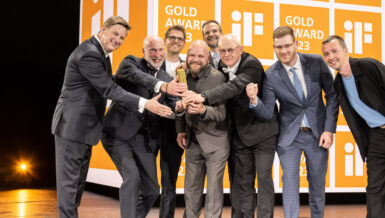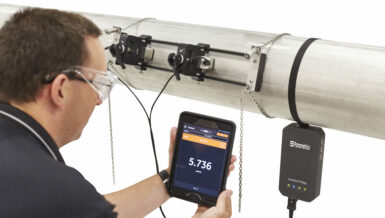Coriolis flow sensor technology has evolved considerably since it was introduced in the 1970s. As the demand for Coriolis grew, the meters were being asked to deliver data with increasing levels of complexity. This meant that Coriolis meters had to adapt and conform to ever-changing installation requirements, process conditions, communication formats, and configuration parameters.
Coriolis mass flowmeters are versatile and highly accurate instruments whose utility extends beyond mass flow, in-line density, and temperature measurement. They have become multifunctional devices that can measure concentrations, work as net oil computers, and even measure heat transport / transfer. The market requires high-end performance from these instruments in demanding process control applications including high-viscosity and non-Newtonian liquids, and dual-phase flows, cryogenic fluids, crushing pressures and boiling temperatures.
The modern Coriolis sensor must be easy-to-use and simple to install.
Manufacturers have evolved Coriolis sensors from a relatively unwieldy instrument to more lightweight and compact models. After all, what is the value of a high precision measurement tool if you cannot get it to fit in your process? The reduction in physical size and minimization of the lay length was accomplished by reducing the length of the tubes, using short radius bends to deliver the needed short lay length and a reduced sensor profile. Additionally, the compact tubes are plumbed with contoured inlet and outlet ports, which aid in reducing, process noise from inlet turbulence.
With short flow tubes and easy bends working in conjunction with the flow conditioning of the inlet ports, modern Coriolis sensors offer impressively low-pressure losses and outstanding signal-to-noise ratios. This means there is more pressure and more signal available for the process.
The modern Coriolis sensor must be able to stand up to the rigors of mounting stresses.
Changes in process pipe temperature can produce tensional, torsional, and compressive forces on the Coriolis sensor as the piping expands and contracts with changing temperatures. For this reason, modern Coriolis flowmeters are designed with construction that is robust to take the strain while not adding unnecessary heft.
This robust construction resists pipe stresses on the process connection, enabling stable and repeatable measurements, even as the pipe stresses alter over time and temperature. The robust design of the sensor, along with the flow conditioning of inlet manifolds, reduce vibratory and process flow noise, offering high repeatability even in the most challenging flow applications and mounting conditions.
Today’s Coriolis meters often take advantage of selecting a resonant tuning frequency of the measurement tubes that is higher than the frequency of a typical environmental disturbances. This minimizes the impact of any external vibration or mechanical noise that could otherwise compromise the meters measurement performance.
Most modern Coriolis meters measure almost set themselves up.
In fact, the latest Coriolis transmitters feature a wide array of filters, adjustment relays and batching controls, as well as customizable display architecture. This technology needs to be easy to access and manipulate, and we see this in the menu structures of today’s Coriolis transmitters, which employ non-technical verbiage with easy-to-understand real word functions.
As part of the HMI (Human-Machine Interface), the transmitters employ wizards that ask if you need help and even suggest a next step. These setup and programing wizards allow even a novice to set up all the primary settings just by answering the questions the meter asks.
The transmitters provide diagnostic and alarm support with easy-to-understand language that reports on the sensor’s condition, and avenues to address any issues the sensor detects.
Easy to install and easy to use seem to be the most common requests from Coriolis users, and manufacturers are responding accordingly. Even with the state-of-the-art technology and features, the latest generation of Coriolis meters are among the most user friendly of flow measurement instruments.
Modern Coriolis meters must have a means to monitor the flow tube health
“Tube Health Check” technology monitors major sensing elements while the flowmeter is in use, generating data that can be used for preventative diagnostics to minimize downtime and consequently reduce maintenance and costs. All diagnostic data is stored on onboard, making data transfer and review easy. The intention of Tube Health Check technology is to monitor accuracy, efficiency, flexibility, etc… and optimize desired performance goals. Tube Health Check systems offer an effective diagnostic tool for a complete meter verification without disturbing the process.
In many of these systems this health check function detects variations in measuring tube stiffness, which can occur due to corrosion, abrasion, or clogging. This is of particular importance, because altered measuring tube stiffness will directly affect the mass flow, volume flow and density measurement. The Tube Health Check is an in-line verification system that can be individually configured to meet the needs of the user and the application. By customizing the frequency of checks, as well as the level of sensitivity the system can monitor and offer a complete custom overview of the devices ability to do its job today and for the long run. These systems offer printable reports that indicate a clear verification result, either pass, fail, or attention needed. Additionally, with the help of trend analysis the Tube Health Check results can improve maintenance schedules and avoid unnecessary service activities, minimizing or eliminating downtime. Collected data can also be used to draw conclusions about the process performance, providing insight that can be used to improve the overall application.
Modern Coriolis sensors must offer highly accurate density measurement
Improving the density measurement accuracy also improves the accuracy of volume flow rate and concentration measurements as they are obtained as a function of density. It is now possible to achieve a density measurement accuracy of 0.008-0.0015 g/cm3 as standard, or an even more accurate measurement figure of 0.0005 g/cm3 with a special measurement option selected.
Modern Coriolis meters are required to deliver a bevy of special functions to meet to meet the growing market demand
With market requirements and process conditions changing, modern Coriolis meters need to offer more than just accuracy and repeatability. They need to provide custom features on demand, providing valuable functions which can be added at any time as they are needed.
Functions such as:
- Concentration measurement functions,
- Net Oil Computing function
- Batching function
- Viscosity function
- Function for measurement of heat quantity
These features are required to adapt to the needs of the process. Additionally, when the process itself changes moment to moment, the best Coriolis meters provide features such as dynamic pressure compensation for applications with broad fluctuations in pressure. Dynamic compensation is important to keep accurate and reliable gas mass flow measurement or volume measurement (based on the density calculation). With the latest Coriolis meters the dynamic pressure compensation function provides continuous and highly accurate results even as the process changes in the meter.
Ultimately, the key challenge for Coriolis utilization is the cost of the technology itself.
In recent years, several manufacturers have released value-priced Coriolis sensors. Even though these Coriolis sensors are still a bit more pricey than other more traditional flow sensors, the capabilities they offer make them an attractive choice from a total cost of ownership perspective.
Budget Coriolis sensors offer flow accuracies of 0.2 -0.75 percent of rate or higher, and this specification remains stable over the life of the meter, which can span 10-20 years. Compare that to a traditional meter that starts at 1% of rate accuracy and can decay over time. In many cases, low-cost Coriolis sensors provide a hefty return on investment in less than one year.
So, the most advanced feature of today’s front line Coriolis meters is their diversity. These meters offer purpose-built application specific devices as well as value priced standard units that perform better than the topline meters of just yesterday. These new meters offer more features, with greater precision, with the ability to be tailored to the specific needs of the user. New applications are being conquered with ease and existing applications are finding it easier to get premier measurement performance from a technology that just a few years ago was priced out of the budget. A Coriolis meter may just be a wiggling pipe, but it is shaking the world of metrology to its core.































